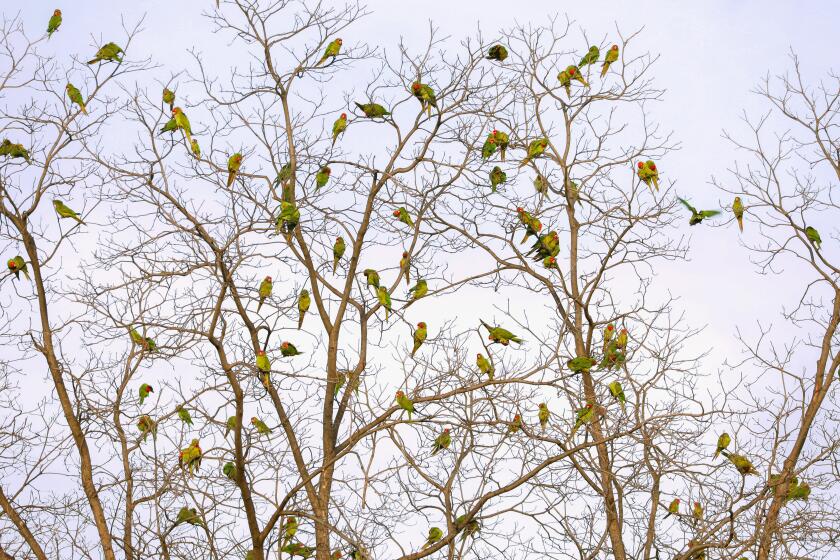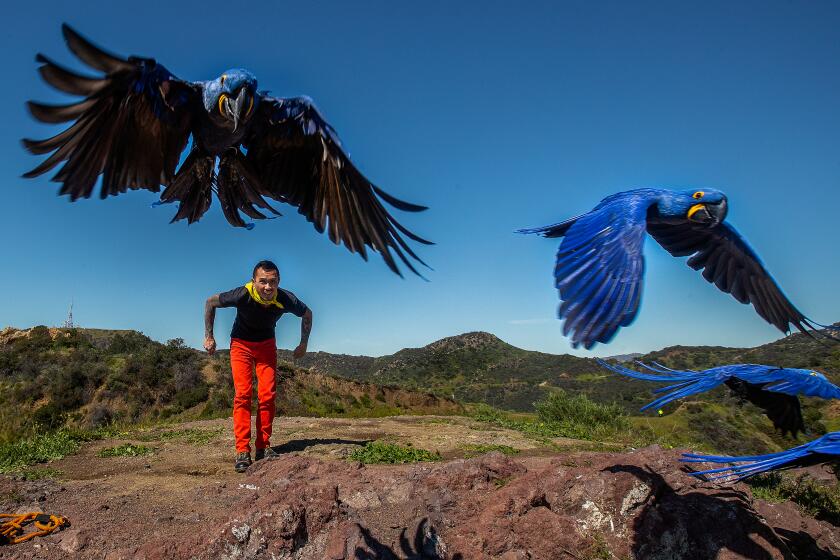Pale Male, red-tailed hawk that nested above New York’s Fifth Avenue for 30 years, dies

- Share via
NEW YORK — Pale Male, a red-tailed hawk who brought a touch of the wild to swanky Manhattan as he nested above Fifth Avenue for three decades, has died. He was believed to be 33 years old.
The renowned raptor died late Tuesday after being found ill and grounded in Central Park, wildlife rehabilitator Bobby Horvath said in a Facebook post.
Horvath wrote that he picked up Pale Male and took him to his rehab group’s veterinarian, who did bloodwork and X-rays. The hawk later ate a small meal but remained weak and lethargic, Horvath said.
“We hoped for any improvement, but sadly it was not meant to be,” Horvath said.
Pale Male, so named because of his whitish plumage, was first spotted in Central Park as a juvenile in 1991 and began nesting on Fifth Avenue, across from the park, in 1993.
Bird lovers crowded inside the park to watch as Pale Male and his succession of mates hatched and raised their young each spring.
How did a dirt parking lot in the San Gabriel Mountains become a major flyway for migrating birds? Scientists can only guess.
The birders were outraged in 2004 when Pale Male’s nest with then-mate Lola was ripped from its ledge on the 12th floor of a ritzy apartment building whose residents included actor Mary Tyler Moore and CNN anchor Paula Zahn. Moore publicly opposed the nest removal.
The co-op board, which had voted to remove the nest as a hazard, quickly reversed itself and restored a row of anti-pigeon spikes that the hawks had used to anchor their nest, and even added a new metal “cradle” on the ledge. Pale Male and Lola rebuilt their nest.
As his legend grew, Pale Male was the subject of a 2009 documentary, “The Legend of Pale Male,” and at least three illustrated children’s books.
Horvath wrote in his post that Pale Male inspired bird lovers and photographers around the world. Some took up bird photography professionally, he wrote, but “most were just local residents or tourists who just wanted an opportunity to get a glimpse of this famous hawk.”
There are a couple of reasons you might be finding it harder than ever to tune out the squawks, whistles and trills of Los Angeles’ wild parrots.
David Barrett, who runs birding Twitter accounts, including Manhattan Bird Alert, said that, for much of Pale Male’s life, “he was not only the world’s most famous red-tailed hawk, but he was probably the world’s most famous bird, one that people knew by name.”
Barrett said the hawk’s fame “shows that even in an intensely urban place like Manhattan, there are many people who have a fondness for wildlife and feel a connection to it.”
It is difficult to know with complete certainty that the hawk that died Tuesday was Pale Male, since Pale Male was never banded.
Some observers began wondering around 2021 whether Pale Male had died and been replaced in the Fifth Avenue nest by another hawk that resembled him.
Chan Quach flies his macaws in L.A. parks, rides his bike with them and takes them out to eat. It’s all part of his mission to make L.A. love birds.
No eggs were observed in the nest in recent breeding seasons, which Barrett said points toward the likelihood that the resident male hawk was in fact an elderly Pale Male, no longer interested in propagating.
Horvath said he believes the hawk whose final hours he witnessed Tuesday was Pale Male, a bird he has been following for 20 years.
“I’ve rescued babies of his that were poisoned,” Horvath said in an interview. “I have a history with his family.”
If Pale Male did live past 30, his life was one of the longest ever recorded for a red-tailed hawk. He survived several mates, including Chocolate, Blue, Lola and Lima. His most recent mate was Octavia.
He is survived by an unknown number of descendants.
More to Read
Sign up for Essential California
The most important California stories and recommendations in your inbox every morning.
You may occasionally receive promotional content from the Los Angeles Times.













